Updated in Vienna, Sunday, April 26, 12:05
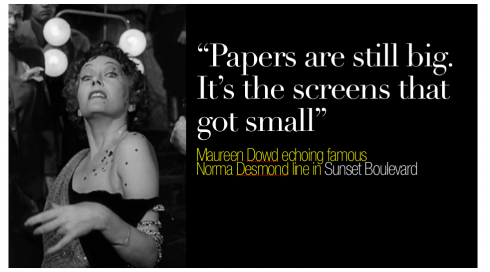
Gloria Swanson in her memorable performance as aging actress Norma Desmond in Sunset Boulevard (1950) the classic Billy Wilder movie
Most delicious weekend read, today’s Maureen Dowd column in The New York Times:
Now that everybody can check their iPhones and laptops for news that personally interests them, now that they can Google, blog and tweet, as well as shop — and stalk — on Craigslist, old-school newspapers seem like aging silent film stars, stricken to find themselves outmoded by technology.
Special Il Secolo XIX siupplement this weekend: celebrating Italy’s Liberation Day

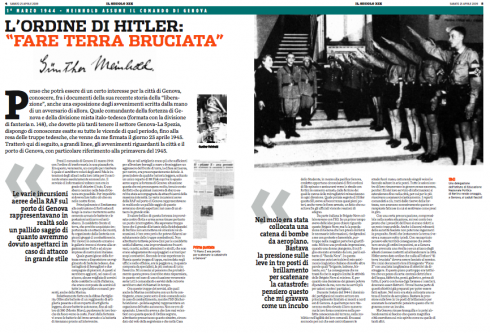
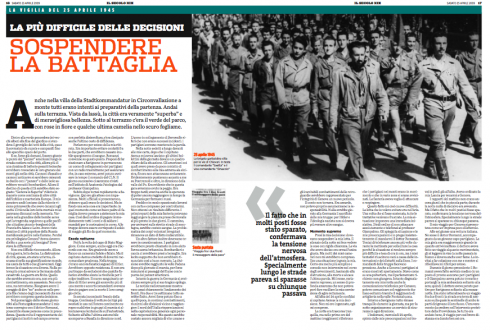
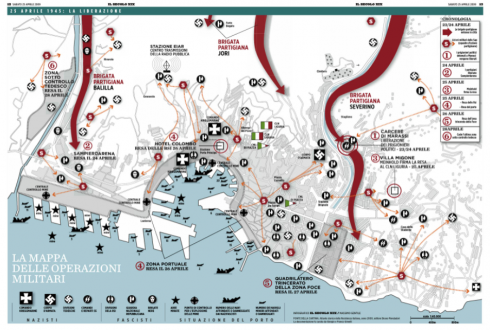

Today, Il Secolo XIX of Genoa, Italy, publishes this 24-page tabloid section to commemorate Liberation Day. This amazing story of one man, one event, came straight from the archives.
The “morgue” was always very alive
I wonder if anyone refers to a newspaper library as a morgue anymore. I know I do.
It shows you I am a product of the newspaper culture of another era. Yes, I imagine that reporters now sit at their desks through long Google sessions when researching their stories..
Great, but, I am glad I was a young reporter in those days when one HAD to get away from his desk and visit the morgue to research the facts of a story. At The Miami News’ morgue, research was the excuse to get in, but the visit always yielded interesting results, including stopping to look through files of topics that had nothing to do with the story of the moment!
Yes, I used to do work at the morgue of The Miami News, the afternoon newspaper of my hometown. Not because I was assigned there, but because I liked to enter the morgue everytime I had a chance, and chat up the librarian, Helen Nunes, a sweet redhead with a touch of Lucille Ball, including the henna-enhanced hair, up in curls, the big and loud laughs, and, if I am not mistaken, she even had a Ricky Ricardo-style husband at home.
As an impressionable 20- year- old fulfilling my journalistic internship at The News, I felt it was a privilege to get my hands on a file titled Frank Sinatra, and see hundreds of photos of the crooner; not to mention that I would often even made copies of items in the Cuba file (big at the time in 1967, bulging with photos of a young, bearded Fidel Castro doing his revolution thing in the Sierra Maestra mountains). I found it delightful and intriguing to read what the Americans were told about events that I had lived thru as a child in Cuba.
The morgue, the library, whatever one called it, you could not be a true journalist and not be fascinated by the surprises that lurked inside all those huge metal cabinets. And the librarians, they were walking Googles in those days. You could approach Helen Nunes and simply say Miss Universe 1963 (Lucky me, I covered those events in Miami!), and she would put down her glazed donut and cup of tea and shout: Brazil—-Ieda Maria Vargas, and rush to get the file with everything anyone would wish to know about that Latin beauty.
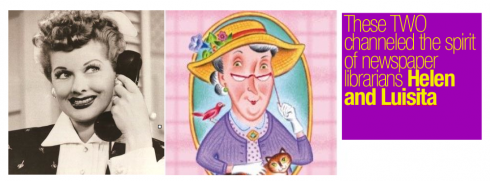
Think Lucille Ball and the Old Maid and you capture the images of the two most memorable newspaper librarians in my mind: Helen Nunes and Luisa DiPietro
Meanwhile, in the Argentine Pampas
I cannot talk about newspaper libraries without mentioning my second favorite newspaper librarian of all times—- Luisa DiPietro, of La Nueva Provincia, of Bahia Blanca, Argentina (the first newspaper I redesigned outside of the USA). Luisita, as she was called, could have posed for the iconic lady on those Old Maid cards of yesteryear. She was also a master chef, and her “dulce de leche” had to be filed under Special Recipe; One of a Kind. She was as sweet as her dulce de leche.
In her case, she could Google you thru the Domingo Peron era, and give you more than Google could provide today about legendary Eva Peron —-because she would do it while serving you tea and dulce de leche. Furthermore, she had been in the Bahia Blanca square the day Evita Peron came to visit there. Try to Google that.
Surprises at Il Secolo XIX’s Library
You see, Massimo Gentile, you started this whole reminiscence about newspaper morgues when you wrote me this week to send me your marvelous story about what you found in the old files of Il Secolo. and the beautifully designed special section published today in your newspaper. Who said that design directors could not initiate journalistic projects?
As Massimo describes it:
Today, April 25, Italy celebrates its Liberation Day, that one memorable occasion in 1945 when the Germans and a large part of the Fascist troops surrendered.
Genoa, where Il Secolo XIX is published, was the only Italian city that was liberated by the “partigiani”, and not by the Allied troops. There was a German General Gunter Meinhold, who opted for surrender rather than follow the usual Hitler line of fighting to the end and destroying the city.
In 1949, Il Secolo XIX got an exclusive interview with General Meinhold, which was published in a 8-part series between April and May of that year.
An old journalist at the newspaper remembered this interview, and a story that is well known among Genoa people, so Il Secolo today recreates it in a 24-page tabloid section, publishing the original interview.
As Massimo describes it:
This is a passionate story about a soldier, not at all sympathizer of Hitler, worried about the war, and concerned not to destroy a city. The entire city was mined, and ready to be blown up in case of defeat. Meinhold made sure it did not happen…..So I have organized all the material, looked up old maps, studied the configuration of the city at that time, and we created great infographics to go with the piece. It is truly marvelous that one can find such rich material in our newspaper archives
Thanks for sharing this, Massimo, and for allowing me to reminisce about Helen and Luisita, and the good times shared in those shrines of the newspaper clips.
And, Helen, I confess: I am the one who took that one photo of Marilyn Monroe—-the one where her skirt goes up as she stands near a street heater.
It is still a prized possession. It is in good hands, sort of from one permanent archive to another.
TweetsByDesign takes off

The new dedicated TweetsByDesign page
This week I made a decision to not just use Twitter, that fascinating autobiographical catcher of life’s little moments, to tell people where I was or going to. The teacher in me began to dream up images of Twitter as a teaching device. Provide simple messages that are direct, to the point, and which, in a way echo what writers in the second century did with Aesop’s Fables, for example, and which I tried to emulate in my book Pure Design.
Yes, the fables and the texts in Pure Design are “long” by Twitter standards (140 characters), but as I started to produce my TweetsByDesign, I am finding out that it is possible to make a statement, and, of course, one can weave a little lesson around a series of TweetsByDesign, as I hope to do with several topics coming down the pipeline.
While blogs may be like a short story, Twitter is like a haiku.
I am hoping that those of you who like the TweetsByDesign will tell others about it.
I doubled the number of my Twitter followers in a 24-hour period this week. Thanks so much.
My favorite audience would be students who are now learning our craft. I want to hear from them, and their professors.
And, oh, yes, I changed from “grandpamario” as an username to TweetsByDesign. Why? Well, a couple of you wrote to ask if Grandpamario was Tweeting from his rocking chair somewhere in Florida.
Considering that it is more likely to be from airport lounges, the back seat of a taxi, or from a fast train between cities in Europe, I figured that Grandpamario on the Go would have been appropriate (yes, I am the proud grandfather of 10 beautiful grandchildren!), but TweetsByDesign can lead you there faster and, I hope, make you comeback.
Twitter on with me!
A new blackletter font now available
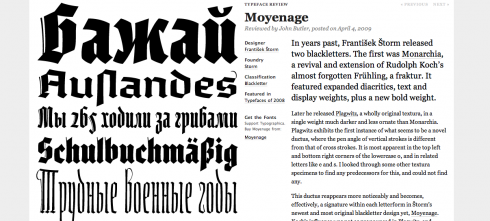
This week we discussed the “return” of blackletter and how many designers, including The New York Times’ Style magazine, use it in imaginative ways. Our friend Reed Reibstein, a soon to be Yale University junior, wrote us and offered this tip, about a newly created blackletter font, Moyenage:
I very much enjoyed your recent blog post on blackletter in newspapers and magazines. I thought that you might be interested in the recent release of what is almost certainly the first blackletter super family. With five widths, five weights, and Greek and Cyrillic versions, Frantisek Storm’s Moyenage could work for anything from headlines to (if one is really adventurous) body text.
L’Equipe Mag out today: second issue after new look

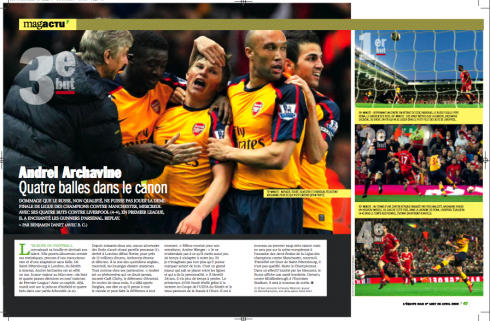
Cover and inside double-page spread of this weekend’s L’Equipe Mag
Art director Francois Lollichon sends us some pdfs of this week’s edition of L’Equipe Mag, the second since we launched it last week. Here a cover and a spread.
Good work, and, more importantly, great reader reaction to the changes. “The readers appreciate the easier navigation the most,” writes editor Jean-Philippe Leclaire.
TheMarioBlog posting #248